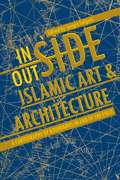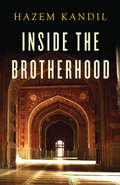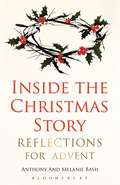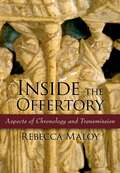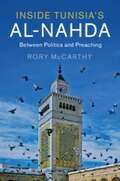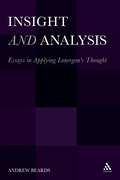- Table View
- List View
Inside a Madrasa: Knowledge, Power and Islamic Identity in India
by Arshad AlamWhile there exists scholarly works on madrasas in India during medieval times and the colonial period, there is hardly anything on the conditions of madrasas today, and those are by and large based on secondary literature and not grounded in detailed empirical investigation. This work, through ethnographic study undertaken at two madrasas in Mubarakpur in Uttar Pradesh, shows how Indian madrasas represent a diverse array of ideological orientations which is mostly opposed to each other’s interpretation of Islam. If madrasas are about the dissemination of Islamic knowledge, then they also problematize and compete over how best to approach that knowledge; in the process they create and sustain a wide variety of possible interpretations of Islam. This volume will be of interest to scholars and researchers interested in the study of Islam and Indian Muslims. Since it is multidisciplinary in approach, it will find space within the disciplines of sociology, social anthropolgy, history and contemporary studies.
Inside The Church of Almighty God: The Most Persecuted Religious Movement in China
by Massimo IntrovigneBranded as "the new Falun Gong" by local authorities, The Church of Almighty God is the most persecuted religious movement in China today. Thousands of police officers are deployed full time to identify and arrest its members. Hundreds of thousands of its devotees are in jail. Authorities claim, perhaps hyperbolically, that it has some four million members and accuse the group of serious crimes. Yet, the movement continues to grow. In this ground-breaking study, Massimo Introvigne offers an inside look at this once-elusive movement, sharing interviews with hundreds of members and the Chinese police officers who hunt them down. The story of The Church of Almighty God is one of rapid growth, dramatic persecution, and the struggle of believers to seek asylum in countries around the world. In his telling of the story, Introvigne reconstructs the Church's idiosyncratic theology, centered in the belief that Jesus Christ has returned in our time in the shape of a Chinese woman, worshipped as Almighty God, to eradicate the sinful nature of humans, and that we have entered the third and final time period in the history of humanity: the Age of Kingdom. A major book from one of the world's leading scholars of new religious movements, Inside The Church of Almighty God is a critical addition to the scholarship of Chinese religion.
Inside The Church of Almighty God: The Most Persecuted Religious Movement in China
by Massimo IntrovigneBranded as "the new Falun Gong" by local authorities, The Church of Almighty God is the most persecuted religious movement in China today. Thousands of police officers are deployed full time to identify and arrest its members. Hundreds of thousands of its devotees are in jail. Authorities claim, perhaps hyperbolically, that it has some four million members and accuse the group of serious crimes. Yet, the movement continues to grow. In this ground-breaking study, Massimo Introvigne offers an inside look at this once-elusive movement, sharing interviews with hundreds of members and the Chinese police officers who hunt them down. The story of The Church of Almighty God is one of rapid growth, dramatic persecution, and the struggle of believers to seek asylum in countries around the world. In his telling of the story, Introvigne reconstructs the Church's idiosyncratic theology, centered in the belief that Jesus Christ has returned in our time in the shape of a Chinese woman, worshipped as Almighty God, to eradicate the sinful nature of humans, and that we have entered the third and final time period in the history of humanity: the Age of Kingdom. A major book from one of the world's leading scholars of new religious movements, Inside The Church of Almighty God is a critical addition to the scholarship of Chinese religion.
Inside/Outside Islamic Art and Architecture: A Cartography of Boundaries in and of the Field
by Saygin SalgirliWhen we walk into a gallery, we have a fairly good idea where the building begins and ends; and inside, while observing a painting, we are equally confident in distinguishing between the painting-proper and its frame and borders. Yet, things are often more complicated. A building defines an exterior space just as much as an interior, and what we perceive to be ornamental and marginal to a given painting may in fact be central to what it represents. In this volume, a simple question is presented: instead of dichotomous separations between inside and outside, or exterior and interior, what other relationships can we think of?The first book of its kind to grapple with this question, Inside/Outside Islamic Art and Architecture focuses on a wide spectrum of mediums and topics, including painted manuscripts, objects, architectural decoration, architecture and urban planning, and photography. Bringing together scholars with diverse methodologies-who work on a geographical span stretching from India to Spain and Nigeria, and across a temporal spectrum from the thirteenth to the twenty-first century-this original book also poses engaging questions about the boundaries of the field.
Inside/Outside Islamic Art and Architecture: A Cartography of Boundaries in and of the Field
When we walk into a gallery, we have a fairly good idea where the building begins and ends; and inside, while observing a painting, we are equally confident in distinguishing between the painting-proper and its frame and borders. Yet, things are often more complicated. A building defines an exterior space just as much as an interior, and what we perceive to be ornamental and marginal to a given painting may in fact be central to what it represents. In this volume, a simple question is presented: instead of dichotomous separations between inside and outside, or exterior and interior, what other relationships can we think of?The first book of its kind to grapple with this question, Inside/Outside Islamic Art and Architecture focuses on a wide spectrum of mediums and topics, including painted manuscripts, objects, architectural decoration, architecture and urban planning, and photography. Bringing together scholars with diverse methodologies-who work on a geographical span stretching from India to Spain and Nigeria, and across a temporal spectrum from the thirteenth to the twenty-first century-this original book also poses engaging questions about the boundaries of the field.
Inside the Brotherhood
by Hazem KandilThis is the first in-depth study of the relationship between the Egyptian Muslim Brotherhood and its own members. Drawing on years of participant observation, extensive interviews, previously inaccessible organizational documents, and dozens of memoirs and writings, the book provides an intimate portrayal of the recruitment and socialization of Brothers, the evolution of their intricate social networks, and the construction of the peculiar ideology that shapes their everyday practices. Drawing on his original research, Kandil reinterprets the Brotherhood’s slow rise and rapid downfall from power in Egypt, and compares it to the Islamist subsidiaries it created and the varieties it inspired around the world. This timely book will be of great interest to students and scholars of the politics of the Middle East and to anyone who wants to understand the dramatic events unfolding in Egypt and elsewhere in the wake of the Arab uprisings.
Inside the Brotherhood
by Hazem KandilThis is the first in-depth study of the relationship between the Egyptian Muslim Brotherhood and its own members. Drawing on years of participant observation, extensive interviews, previously inaccessible organizational documents, and dozens of memoirs and writings, the book provides an intimate portrayal of the recruitment and socialization of Brothers, the evolution of their intricate social networks, and the construction of the peculiar ideology that shapes their everyday practices. Drawing on his original research, Kandil reinterprets the Brotherhood’s slow rise and rapid downfall from power in Egypt, and compares it to the Islamist subsidiaries it created and the varieties it inspired around the world. This timely book will be of great interest to students and scholars of the politics of the Middle East and to anyone who wants to understand the dramatic events unfolding in Egypt and elsewhere in the wake of the Arab uprisings.
Inside the Christmas Story: Reflections for Advent
by Anthony Bash Melanie BashIf you are troubled by the loss of 'Christ' in 'Christmas'; and by the noise, pressure and materialism of secular Advent with its emphasis on material and commercial rather than spiritual preparation for Christmas, this book will help you to read and think about Advent and Christmas in a new way. Co-authored by a New Testament specialist and a practising clinical psychologist, it explores the familiar narratives from the Christmas story with freshness and vigour, and draws out their implications for day-to-day living. The Christmas story is full of themes that we often avoid in churches - asylum seekers and refugees; death; loss and suffering; old age; childlessness - but they can give a new depth and meaning to our Christmas celebrations. Christmas will not seem the same again.
Inside the Christmas Story: Reflections for Advent
by Anthony Bash Melanie BashIf you are troubled by the loss of 'Christ' in 'Christmas'; and by the noise, pressure and materialism of secular Advent with its emphasis on material and commercial rather than spiritual preparation for Christmas, this book will help you to read and think about Advent and Christmas in a new way. Co-authored by a New Testament specialist and a practising clinical psychologist, it explores the familiar narratives from the Christmas story with freshness and vigour, and draws out their implications for day-to-day living. The Christmas story is full of themes that we often avoid in churches - asylum seekers and refugees; death; loss and suffering; old age; childlessness - but they can give a new depth and meaning to our Christmas celebrations. Christmas will not seem the same again.
Inside the Muslim Brotherhood: Religion, Identity, and Politics (Religion and Global Politics)
by Khalil al-AnaniOver the past three decades, through rises and falls in power, regime repression and exclusion, the Egyptian Muslim Brotherhood has endured, proving more resilient than any other Islamist movement in the world. In this book Khalil al-Anani explores the factors that have enabled the Brotherhood to survive so long within an ever-changing political landscape. Inside the Muslim Brotherhood unpacks the principal factors that shape the movement's identity, organization, and activism. Investigating the processes of socialization, indoctrination, recruitment, identification, networking, and mobilization that characterize the movement, al-Anani argues that the Brotherhood is not merely a political actor seeking power but an identity-maker that aims to change societal values, norms, and morals to line up with its ideology and worldview. The Brotherhood is involved in an intensive process of meaning construction and symbolic production that shapes individuals' identity and gives sense to their lives. The result is a distinctive code of identity that binds members together, maintains their activism, and guides their behavior in everyday life. Al-Anani attributes the Brotherhood's longevity to its tight-knit structure coupled with a complex membership system that has helped them resist regime penetration. The book also explores the divisions and differences within the movement and how these affect its strategy and decisions. The culmination of over a decade of research and interviews with leaders and members of the movement, this book challenges the dominant narratives about Islamists and Islamism as a whole.
Inside the Muslim Brotherhood: Religion, Identity, and Politics (Religion and Global Politics)
by Khalil al-AnaniOver the past three decades, through rises and falls in power, regime repression and exclusion, the Egyptian Muslim Brotherhood has endured, proving more resilient than any other Islamist movement in the world. In this book Khalil al-Anani explores the factors that have enabled the Brotherhood to survive so long within an ever-changing political landscape. Inside the Muslim Brotherhood unpacks the principal factors that shape the movement's identity, organization, and activism. Investigating the processes of socialization, indoctrination, recruitment, identification, networking, and mobilization that characterize the movement, al-Anani argues that the Brotherhood is not merely a political actor seeking power but an identity-maker that aims to change societal values, norms, and morals to line up with its ideology and worldview. The Brotherhood is involved in an intensive process of meaning construction and symbolic production that shapes individuals' identity and gives sense to their lives. The result is a distinctive code of identity that binds members together, maintains their activism, and guides their behavior in everyday life. Al-Anani attributes the Brotherhood's longevity to its tight-knit structure coupled with a complex membership system that has helped them resist regime penetration. The book also explores the divisions and differences within the movement and how these affect its strategy and decisions. The culmination of over a decade of research and interviews with leaders and members of the movement, this book challenges the dominant narratives about Islamists and Islamism as a whole.
Inside the Offertory: Aspects of Chronology and Transmission
by Rebecca MaloyThe offertory has played a crucial role in recent vigorous debates about the origins of Gregorian chant. Its elaborate solo verses are among the most splendid of chant melodies, yet the verses ceased to be performed in the twelfth and thirteenth centuries, making them among the least known and studied members of the repertory. Rebecca Maloy now offers the first comprehensive investigation of the offertory, drawing upon its music, texts, and liturgical history to shed new light on its origins and chronology. Maloy addresses issues that are at the very heart of chant scholarship, such as the relationship between the Gregorian and Old Roman melodies, the nature of oral transmission, the presence of non-Roman pieces in the Gregorian repertory, and the influence of theoretical thought on the transmission of the melodies. Although the Old Roman chant versions were not recorded in writing until the eleventh century, it has long been assumed that they closely reflect the eighth-century state of the melodies. Maloy illustrates, however, that rather than preserving a pristine earlier version of the melodies, the prolonged period of oral transmission from the eighth to the eleventh centuries instead enforced a formulaic trend. Demonstrating that certain musical and textual traits of the offertory are distributed in distinct patterns by liturgical season, she outlines new chronological layers within the repertory, and along the way, explores the presence and implications of foreign imports into the Roman and Gregorian repertories. Carefully weighing questions surrounding the origins of elaborate verse melodies, Maloy deftly establishes that these melodies reached their final form at a relatively late date. Available for the first time as a complete critical edition, ninety-four Gregorian and Old Roman offertories are presented on a companion website in transcriptions which readers can view side-by-side. The book also provides music examples and essays that elucidate these transcriptions with significant insights into their similarities and differences. Inside the Offertory will be an important and longstanding resource for all students and scholars of early liturgical music, as well as performers of early music and medievalists interested in music.
Inside the Offertory: Aspects of Chronology and Transmission
by Rebecca MaloyThe offertory has played a crucial role in recent vigorous debates about the origins of Gregorian chant. Its elaborate solo verses are among the most splendid of chant melodies, yet the verses ceased to be performed in the twelfth and thirteenth centuries, making them among the least known and studied members of the repertory. Rebecca Maloy now offers the first comprehensive investigation of the offertory, drawing upon its music, texts, and liturgical history to shed new light on its origins and chronology. Maloy addresses issues that are at the very heart of chant scholarship, such as the relationship between the Gregorian and Old Roman melodies, the nature of oral transmission, the presence of non-Roman pieces in the Gregorian repertory, and the influence of theoretical thought on the transmission of the melodies. Although the Old Roman chant versions were not recorded in writing until the eleventh century, it has long been assumed that they closely reflect the eighth-century state of the melodies. Maloy illustrates, however, that rather than preserving a pristine earlier version of the melodies, the prolonged period of oral transmission from the eighth to the eleventh centuries instead enforced a formulaic trend. Demonstrating that certain musical and textual traits of the offertory are distributed in distinct patterns by liturgical season, she outlines new chronological layers within the repertory, and along the way, explores the presence and implications of foreign imports into the Roman and Gregorian repertories. Carefully weighing questions surrounding the origins of elaborate verse melodies, Maloy deftly establishes that these melodies reached their final form at a relatively late date. Available for the first time as a complete critical edition, ninety-four Gregorian and Old Roman offertories are presented on a companion website in transcriptions which readers can view side-by-side. The book also provides music examples and essays that elucidate these transcriptions with significant insights into their similarities and differences. Inside the Offertory will be an important and longstanding resource for all students and scholars of early liturgical music, as well as performers of early music and medievalists interested in music.
Inside the Vatican: The Politics And Organization Of The Catholic Church
by Thomas S.J. ReeseDrawing on more than a hundred interviews with Vatican officials, this book affords a firsthand look at the people, the politics, and the organization behind the institution. Throughout, revealing and colorful anecdotes from church history and the present day bring the unique culture of the Vatican to life.
Inside the Vatican: The Politics And Organization Of The Catholic Church
by Thomas S.J. ReeseDrawing on more than a hundred interviews with Vatican officials, this book affords a firsthand look at the people, the politics, and the organization behind the institution. Throughout, revealing and colorful anecdotes from church history and the present day bring the unique culture of the Vatican to life.
Inside Tunisia's Al-nahda: Between Politics And Preaching (Cambridge Middle East Studies #Series Number 53)
by Rory McCarthyIn the wake of the Arab uprisings, al-Nahda voted to transform itself into a political party that would for the first time withdraw from a preaching project built around religious, social, and cultural activism. This turn to the political was not a Tunisian exception but reflects an urgent debate within Islamist movements as they struggle to adjust to a rapidly changing political environment. This book re-orientates how we think about Islamist movements. Drawing on extensive fieldwork with grassroots activists of Tunisia's al-Nahda, Rory McCarthy focuses on the lived experience of activism to offer a challenging new perspective on one of the Middle East's most successful Islamist projects. Original evidence explains how al-Nahda survived two decades of brutal repression in prison and in social exclusion, and reveals what price the movement paid for a new strategy of pragmatism and reform during the Tunisian transition away from authoritarianism.
The Insider and the Outcast: The Encounters with Jesus Series: 2
by Timothy KellerThe Gospels are full of encounters that made a profound impact on those who spoke with Jesus Christ. In the second essay of his new series, Timothy Keller, pastor of New York's Redeemer Presbyterian Church and New York Times-bestselling author of The Reason for God, shows how those encounters can still have a deep effect on us today. By examining the biblical passages where Jesus speaks with an insider, Nicodemus, a member of the Jewish ruling council, and an outsider, a Samaritan woman, Keller sheds light on the subject of sin - the biblical concept for what is wrong with the world. This second essay in the ten-part Encounters with Jesus series also includes an exclusive look at Timothy Keller's book on faith and work: Every Good Endeavour: Connecting Your Work to God's Work.This and the other nine in the series make up the complete Encounters With Jesus: Unexpected Answers to Life's Biggest Questions.
The Insider/Outsider Problem in the Study of Religion: A Reader (Controversies in the Study of Religion)
by Russell McCutcheonThirty classic and contemporary readings - from such writers as Kant, Hume, Schleiermacher, and Otto, to Ninian Smart, Mircea Eliade, Karen McCarthy-Brown, and Wendy Doniger.
Insiders and Outsiders: Dilemmas of East European Jewry (The Littman Library of Jewish Civilization)
Insiders and Outsiders: Dilemmas of East European Jewry examines problems of Jewish cultural and political orientations, associations, and self-identification within a broad framework. The contributors approach the predicament of east European Jews in various settings: some focus primarily on the Jews' inner development and outlook, while others discuss how elements of the majority society viewed their presence. Scholars of history, art history, and literature display originality and insight in illuminating the nuances and intricacies of the Jewish ‘outsider’. Following an overview by the distinguished intellectual historian of German Jewry Steven Aschheim, who offers some comprehensive thoughts on the insider/outsider dilemma in modern times and its relevance to eastern Europe, the discussion evolves around three major themes: the cultural conundrum; modes of acculturation, assimilation, and identity; and the minority’s inclusion in or exclusion from the political agendas of certain east European societies. It concludes with a focus on two remarkable cities―Czernowitz and Vilnius―where the Jewish minority has often been conceived as being no less ‘inside’ than other groups. Contributors to the ‘cultural conundrum’ section deal with artists and writers from Romania and Poland who have gained wide public and critical attention over the years, including Reuven Rubin, Itzik Manger, Avot Yeshurun, and Mihail Sebastian. Other essays discuss the work of a group of writers from Poland, including Henryk Grynberg, Wilhelm Dichter, Joanna Olczak-Ronikier, Krzysztof Teodor Toeplitz, and Michal Glowinski, who reflected intensively on their experiences as Jews in the Second World War and tried to integrate these experiences into their often fractured identities. The complex personal evolution of these figures shows the multi-layered influences on their creativity and imagination, while underscoring the dilemmas they faced to find points of meeting between their Jewish background and their national identity. The section on modes of acculturation, assimilation, and identity offers detailed analyses of the ways in which multi-ethnic and multi-national situations demand that the ‘outsider’, consciously or unconsciously, develop inner strategies to fashion a specific identity. Surveying such vibrant areas as Czechoslovakia and Poland between the two world wars and the city of Lwów in the late nineteenth century, three essays present some of the choices Jews made in order to deal with the changing political and cultural context. Their meditations on belonging and not-belonging―on the constitution of identity and its fluidity, and on the formation, breakdown, and reconfiguration of physical, mental, social, and geographical borders―acquire a special relevance and urgency in these settings. How did Jews as ‘outsiders’ configure their political allegiance in eastern Europe? How prominent were they in the radical elements of the communist movement in Russia? What tactics did they employ to safeguard their future in such societies and what means did they employ to galvanize the ‘Jewish street’? These are some of the questions raised in the section on society and politics, which delves into such problematic terrain as ‘Jewish informers’, the ‘non-Jewish Jew’, and ‘Jewish politics’. The concluding essays examine the tensions, paradoxes, and ironies of the phenomenon of the Jewish outsider in Czernowitz and Vilnius, two cities where, indeed, Jews were often construed to be the true ‘insiders’.CONTRIBUTORS: Steven E. Aschheim, Karen Auerbach, Richard I. Cohen, Jonathan Frankel, Stefani Hoffman, Zvi Jagendorf, Hillel J. Kieval, Rachel Manekin, Amitai Mendelsohn, Joanna B. Michlic, Antony Polonsky, David Rechter, Scott Ury, Leon Volovici, Ruth R. Wisse, Mordechai Zalkin
Insight and Analysis: Essays in Applying Lonergan's Thought
by Andrew BeardsThis book applies Bernard Lonergan's thought to current issues in philosophy and in moral and other areas of theology.
Insight Dialogue: (pdf)
by Gregory KramerInsight Dialogue is a way of bringing the tranquility and insight attained in meditation directly into your interactions with other people. It's a practice that involves interacting with a partner in a retreat setting or on your own, as a way of accessing a profound kind of insight. Then, you take that insight on into the grind of everyday human interactions. Gregory Kramer has been teaching the practice (which he originated) for more than a decade in retreats around the world. It's something strikingly new in the world of Buddhist practice--yet it's completely grounded in traditional Buddhist teaching. Kramer begins with a detailed presentation of the central Buddhist teaching of the Four Noble Truths seen through an interpersonal lens. Because dukkha (suffering or unsatisfactoriness) is often most forcefully felt in our relations with others, interpersonal relationships are a wonderfully useful place to practice. He breaks the Noble Truths down into component parts to observe how they manifest particularly in relationship to others, using examples from his own life and practice, as well as from his students'. He then goes on to present the practice as it's taught in his workshops and retreats. There are a few basic steps to the practice, deceptively simple to describe: (1) pause, (2) relax, (3) open, (4) trust emergence, (5) listen deeply, and (6) speak the truth. The sequence begins following a period of meditation, and includes periods of speaking, listening, and mutual silence. Kramer includes numerous examples of people's experience with the practice from his retreats, and shows how the insight gained from the techniques can be brought into real life. More than just testimonials for how well the practice "works," the personal stories demonstrate the problems that arise, the different routes the practice can follow, and the sometimes surprising insights that are gained. To learn more about the author, Gregory Kramer, go to www.metta.org.
Inspiration (New Century Theology)
by David R. LawLaw develops his theory of inspiration starting with texts as varied as Virgil's Aeneid and Shakespeare's plays before focusing on the Bible. Following Karl Jaspers, Law views all human knowledge as having limits beyond which there exists the Transcendent. He believes that there are symbols, signs and characters-or "ciphers"-that inhabit religion and art and which point beyond these horizons. Perceiving these is at the heart of inspiration and the knowledge of God. For Law, the key to the question of inspiration and the Bible lies with understanding the reader's encounter with these ciphers, the supreme of which is Christ.
Inspiration: Towards a Christian Interpretation of Biblical Inspiration
by Gerald O'Collins, SJInspiration: Towards a Christian Interpretation of Biblical Inspiration anchors its study of inspiration firmly in the Scriptures and examines the inspired nature of the Bible and its inspiring impact. Gerald O'Collins begins by examining classical view of inspiration expounded by Karl Barth and Raymond Collins. He takes up the inspired origin of the Old Testament, where earlier books helped to inspire later books, before moving to the New Testament, which throughout shows the inspiring impact of the inherited Scriptures—both in direct citations and in many echoes. The work then investigates the Bible's inspiring influence on Christian worship, preaching, teaching, the visual arts, literature, and life. After a chapter that clarifies the interrelationship between divine revelation, tradition, and inspiration, two chapters expound ten characteristics of biblical inspiration, with special emphasis on the inspiring quality of the Bible. O'Collins explains a major consequence of inspiration, biblical truth, and the grounds on which the Church 'canonized' the Scriptures. After spelling out three approaches to biblical interpretation (the authorial intention, the role of readers, and the primacy of the text itself), the book ends by setting out ten principles for engaging theologically with the Scriptures. An epilogue highlights two achievements of the book. By carefully distinguishing inspiration from divine revelation and biblical truth, it can deliver readers from false problems. This work also underlines the inspiring effects of the Scriptures as part of the Holy Spirit's work of inspiration.
Inspiration: Towards a Christian Interpretation of Biblical Inspiration
by Gerald O'Collins, SJInspiration: Towards a Christian Interpretation of Biblical Inspiration anchors its study of inspiration firmly in the Scriptures and examines the inspired nature of the Bible and its inspiring impact. Gerald O'Collins begins by examining classical view of inspiration expounded by Karl Barth and Raymond Collins. He takes up the inspired origin of the Old Testament, where earlier books helped to inspire later books, before moving to the New Testament, which throughout shows the inspiring impact of the inherited Scriptures—both in direct citations and in many echoes. The work then investigates the Bible's inspiring influence on Christian worship, preaching, teaching, the visual arts, literature, and life. After a chapter that clarifies the interrelationship between divine revelation, tradition, and inspiration, two chapters expound ten characteristics of biblical inspiration, with special emphasis on the inspiring quality of the Bible. O'Collins explains a major consequence of inspiration, biblical truth, and the grounds on which the Church 'canonized' the Scriptures. After spelling out three approaches to biblical interpretation (the authorial intention, the role of readers, and the primacy of the text itself), the book ends by setting out ten principles for engaging theologically with the Scriptures. An epilogue highlights two achievements of the book. By carefully distinguishing inspiration from divine revelation and biblical truth, it can deliver readers from false problems. This work also underlines the inspiring effects of the Scriptures as part of the Holy Spirit's work of inspiration.


